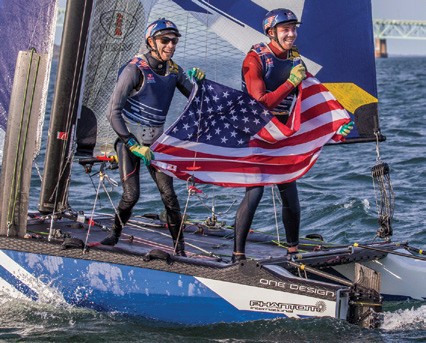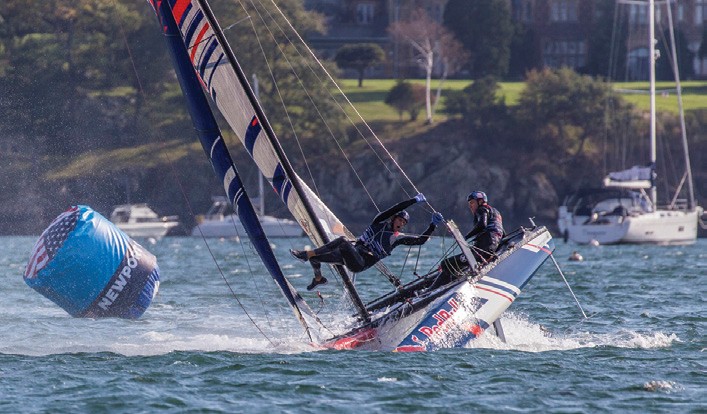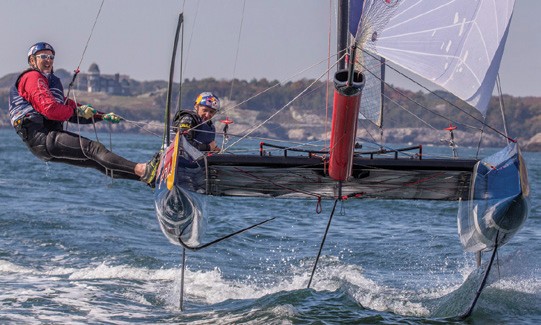Competitors in the Red Bull Foiling Generation USA Qualifier have lofty ambitions
By Joe Cooper
 There were a couple of the usual scenes to be seen when I walked onto the North Green at Fort Adams State Park in Newport, RI on the Sunday of the Red Bull Foiling Generation USA Qualifier series in mid-October. Most of it was the usual ‘stuff’ of big regattas: Red Bull branded tents and related chairs, tables, and so on. The 18-foot Flying Phantom foiling cats zooming around the harbor like so many Quidditch players, the announcer, the rock music, etc. The more nuanced scenes were off the water and inside the tent.
There were a couple of the usual scenes to be seen when I walked onto the North Green at Fort Adams State Park in Newport, RI on the Sunday of the Red Bull Foiling Generation USA Qualifier series in mid-October. Most of it was the usual ‘stuff’ of big regattas: Red Bull branded tents and related chairs, tables, and so on. The 18-foot Flying Phantom foiling cats zooming around the harbor like so many Quidditch players, the announcer, the rock music, etc. The more nuanced scenes were off the water and inside the tent.
The winners of the Red Bull Foiling Generation USA Qualifier, Quinn Wilson and Riley Gibbs represented the United States in the World Final. ©Stephen Cloutier/photogroup.us
There was a very nice ‘hospitality’ tent set up with glass front, timber floor, lounges and chairs, double doors and one of the barricades, common at the TSA line in airports, guarding the front door. Unusual though, in fact the first time I think I have seen sailors described so, was the sign on the barrier: ‘Athletes Lounge.’
Inside the Athletes Lounge were some athletes lounging. Another unusual aspect was that a couple of them were engrossed in schoolwork; these young sailors are, after all, between 16 and 20. An early indicator of the future of high performance sailing in the U.S. was the answers from two sailors when I asked what they were studying in college. One was Math at Georgetown and the second was Aeronautics and Astrophysics at Stanford.

With boats capable of 35 knots, wipeouts in the Red Bull Foiling Generation are frequently spectacular. © Stephen Cloutier/photogroup.us
At one of the desks was Red Bull’s Energizer Bunny, Kerri Holt, my host and guide for the day. I wondered if I could talk with some of the athletes and was introduced to one of the pairs, brothers Luke and Nicholas Muller. I soon discovered what these two had in common with the other sailors I spoke with. Great self-assurance, great personalities and ‘press smarts,’ but most of all a focus. These guys knew what they wanted and were going full on towards it. In the athlete bio booklet Kerri gave me, there is a rundown of the men and women – alas only three of the latter – and the America’s Cup, Volvo Ocean Race, Olympics and professional sailing loom large in the ‘sailing goals’ category. Interesting too were the two different sailors expressing interest in the Trophy Jules Verne and the Mini Transat.
“How did it all start?” I wondered aloud. “How did you start sailing?” Actually, Luke and Nicholas reminded me of me. Their parents were windsurfers and they grew up in Ft. Pierce, FL. They really had no chance since they were in on and around the water from birth. They did not belong to a yacht club but rather sailed out of the US Sailing Center of Martin County. This is in effect a Florida version of Sail Newport, a community sailing center focusing on getting kids sailing.
When did the America’s Cup waft across their senses? “It was just sort of always there,” said Nicholas. “I did see videos of the races in Valencia in the monohulls, and that sort of reinforced the America’s Cup as the pinnacle of our sport, a goal to be aimed at.” Since today it seems that the biggest chunk of the professional sailing world is focused around the Volvo, the America’s Cup and the Olympics, and the bulk of the sailors in all three are the same guys (and some girls), Luke is already in a slight lift in that he was the training partner for Caleb Paine in Rio. Interestingly another athlete I spoke with, Scott Ewing of Miami (and of a very appropriate Finn size) remarked, when I suggested he ought to be sailing a Finn, shook his head and said, “Finns were not fast enough.” It ought to be noted that the 205 lb. Ewing has a foiling Moth…
Haddon Hughes, from Houston, TX and one of only three ladies in the USA Qualifier, did come through the rather more normal path, the yacht club junior program. Starting at eight and quickly taking to the fun part of sailing, Haddon progressed through the Opti Color scheme. At 14, she moved into the Laser 4.7 and soon the Laser Radial. Haddon realized she liked the feeling of winning and took that drive up to a fifth (of 40) in the 2013 ISAF Junior Worlds in Cyprus and then to a second (of 46) in the same regatta in 2014 in Portugal. Biggest motivator? “That awful feeling in the pit of your stomach when you fail, for yourself, is something that really drives me,” she said. “That feeling really set me on my focus for the Laser Radial spot in the 2020 Olympics. The America’s Cup, VOR and anything else is secondary to focusing on going to Japan.”
In one of the ‘Back to the Future’ moments, I met a young fellow named Ian MacDiarmid. One of the partners at Elvstrøm Sails in Sydney, where I worked years ago, was of the same name. When I mentioned this to the youthful Ian, he responded that he knew him, at least via email. Makes sense, since Ian the Younger sails a 29er (and the 49er and 49er FX) and Ian the Senior has (or originally had) the contract for making the one-design sails for this sporty little boat.

Flyin’ the Coop: Our intrepid Contributing Editor (on the wire) went for a ride with Red Bull Foiling Generation co-founder Roman Hagara. We’ve heard that he’s still grinning. © Stephen Cloutier/photogroup.us
Ian MacD. (as we all used to call Ian the Elder) and Scott Ewing are one of several pairs from the coast of Florida. In fact five of the pairs (10 sailors) hail from the sunshine coast – five each from California and Texas, two from Hawaii and one each from Oregon, Washington State, Boston, Martha’s Vineyard, Middletown, RI, and one young lady from the UK.
Looking too at the ‘boats sailed’ categories in their bios, high performance sailing rules. 29er, 49er, a variety of cats, 18-foot skiffs, foiling Moths and 5O5s were pretty common. Kiteboarding and windsurfing were well represented, and a surprising number has sailed on performance keelboats including Melges and TP 52s.
In the program booklet with the sailor bios there was also a section in which each identified the “best place to sail in the world,” “best sailor in the world,” “best coaches on the planet,” “personal heroes,” and my favorite, “your motto in life.” This gives a great insight into people, I reckon. Not surprisingly, they were almost universally performance and success oriented. Number two on my list of favorites was Yoda’s classic “No try-do or not do,” but given the boats these young men and women were sailing the winner has to be Parker Hughes of Texas with: “If everything seems under control you are not going fast enough.”



